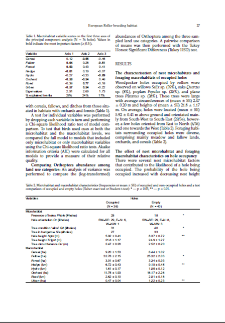- Search in all Repository
- Literature and maps
- Archeology
- Mills database
- Natural sciences
Advanced search
Advanced search
Advanced search
Advanced search
Advanced search

Object
Title: Genetic variability of Polish population of the capercaillie Tetrao urogallus
Creator:
Rutkowski, Robert (zootechnika) ; Polska Akademia Nauk. Muzeum i Instytut Zoologii.
Date issued/created:
Resource type:
Subtitle:
Acta Ornithologica, vol. 40, no. 1 ; Zmienność genetyczna polskich populacji głuszca
Contributor:
Museum and Institute of Zoology, Polish Academy of Sciences
Publisher:
Place of publishing:
Description:
Bibliogr. s. 33-34 ; S. [27]-34 : il. ; 27 cm ; Streszcz. pol.
Type of object:
Abstract:
The Capercaillie is one of the most seriously endangered bird species in Poland. It currently numbers around 650 individuals that live in four isolated populations (Lower Silesian Forest, Janów Lubelski Forest, Carpathians, Augustów Forest). This study investigated genetic variability based on the polymorphism of six microsatellite loci in the surviving Polish populations of the Capercaillie and compares the results with the analogous variability in two large, contiguous populations in Russia. The following parameters were estimated: mean number of alleles per locus, allelic richness, mean effective number of alleles per locus, heterozygosity in each of the populations investigated. Differentiation between pairs of populations was assessed using FST. The results show that despite some inevitable reduction in genetic variability, most of the Polish populations retained a substantial level of microsatellite polymorphism. Only in the population from Janów Lubelski Forest was there a significant reduction in variability, probably due to long isolation and the recent decline. That this population has long been isolated was also confirmed by the pronounced genetic differentiation from the other Polish populations. The Carpathian population of the Capercaillie was found to be genetically structured, and in the Lower Silesian Forest population heterozygosity was lower, possibly as a result of the lek mating system and also the dramatic reduction in numbers.
Relation:
Volume:
Issue:
Start page:
End page:
Detailed Resource Type:
Format:
Resource Identifier:
Source:
MiIZ PAN, sygn. patrz sygn. czas. P.257, Vol. 40, No 1 ; MiIZ PAN, sygn. patrz sygn. czas. P.4568, Vol. 40, No 1 ; click here to follow the link
Language:
Language of abstract:
Rights:
Prawa zastrzeżone - dostęp nieograniczony
Terms of use:
Digitizing institution:
Muzeum i Instytut Zoologii Polskiej Akademii Nauk
Original in:
Library of the Museum and Institute of Zoology of the Polish Academy of Sciences
Projects co-financed by:
Program Operacyjny Innowacyjna Gospodarka, lata 2010-2014, Priorytet 2. Infrastruktura strefy B + R ; Unia Europejska. Europejski Fundusz Rozwoju Regionalnego
Access:
Object collections:
- Digital Repository of Scientific Institutes > Partners' collections > Museum and Institute of Zoology PAS > Scientific Journals
- Digital Repository of Scientific Institutes > Partners' collections > Museum and Institute of Zoology PAS > MIZ PAN Publications > Acta Ornithologica
- Digital Repository of Scientific Institutes > Literature > Journals/Articles
Last modified:
Feb 4, 2025
In our library since:
Jul 28, 2015
Number of object content downloads / hits:
55
All available object's versions:
https://rcin.org.pl./publication/74859
Show description in RDF format:
Show description in RDFa format:
Show description in OAI-PMH format:
| Edition name | Date |
|---|---|
| Genetic variability of Polish population of the capercaillie Tetrao urogallus / Rutkowski, R. | Feb 4, 2025 |
Objects Similar
Zhou, Yi-Biao Zhao, Gen-Ming Jiang, Quing-Wu
Domaniewski, Janusz (1891–1954)
Domaniewski, Janusz (1891–1954)
Szczepański, Sebastian Santorek, Anna Dulisz, Beata Żurek, Zbigniew Armatys, Paweł Rutkowski, Robert
Rutkowski, Robert Dulisz, Beata Szczepański, Sebastian Nowakowski, Jacek J. Zwijacz-Kozica, Tomasz Krzan, Piotr
Santorek, Anna Zwijacz-Kozica, Tomasz Dulisz, Beata Merta, Dorota Rutkowski, Robert
Kurt, F. Hartl, G. B. Völk, F.

 INSTYTUT ARCHEOLOGII I ETNOLOGII POLSKIEJ AKADEMII NAUK
INSTYTUT ARCHEOLOGII I ETNOLOGII POLSKIEJ AKADEMII NAUK
 INSTYTUT BADAŃ LITERACKICH POLSKIEJ AKADEMII NAUK
INSTYTUT BADAŃ LITERACKICH POLSKIEJ AKADEMII NAUK
 INSTYTUT BADAWCZY LEŚNICTWA
INSTYTUT BADAWCZY LEŚNICTWA
 INSTYTUT BIOLOGII DOŚWIADCZALNEJ IM. MARCELEGO NENCKIEGO POLSKIEJ AKADEMII NAUK
INSTYTUT BIOLOGII DOŚWIADCZALNEJ IM. MARCELEGO NENCKIEGO POLSKIEJ AKADEMII NAUK
 INSTYTUT BIOLOGII SSAKÓW POLSKIEJ AKADEMII NAUK
INSTYTUT BIOLOGII SSAKÓW POLSKIEJ AKADEMII NAUK
 INSTYTUT CHEMII FIZYCZNEJ PAN
INSTYTUT CHEMII FIZYCZNEJ PAN
 INSTYTUT CHEMII ORGANICZNEJ PAN
INSTYTUT CHEMII ORGANICZNEJ PAN
 INSTYTUT FILOZOFII I SOCJOLOGII PAN
INSTYTUT FILOZOFII I SOCJOLOGII PAN
 INSTYTUT GEOGRAFII I PRZESTRZENNEGO ZAGOSPODAROWANIA PAN
INSTYTUT GEOGRAFII I PRZESTRZENNEGO ZAGOSPODAROWANIA PAN
 INSTYTUT HISTORII im. TADEUSZA MANTEUFFLA POLSKIEJ AKADEMII NAUK
INSTYTUT HISTORII im. TADEUSZA MANTEUFFLA POLSKIEJ AKADEMII NAUK
 INSTYTUT JĘZYKA POLSKIEGO POLSKIEJ AKADEMII NAUK
INSTYTUT JĘZYKA POLSKIEGO POLSKIEJ AKADEMII NAUK
 INSTYTUT MATEMATYCZNY PAN
INSTYTUT MATEMATYCZNY PAN
 INSTYTUT MEDYCYNY DOŚWIADCZALNEJ I KLINICZNEJ IM.MIROSŁAWA MOSSAKOWSKIEGO POLSKIEJ AKADEMII NAUK
INSTYTUT MEDYCYNY DOŚWIADCZALNEJ I KLINICZNEJ IM.MIROSŁAWA MOSSAKOWSKIEGO POLSKIEJ AKADEMII NAUK
 INSTYTUT PODSTAWOWYCH PROBLEMÓW TECHNIKI PAN
INSTYTUT PODSTAWOWYCH PROBLEMÓW TECHNIKI PAN
 INSTYTUT SLAWISTYKI PAN
INSTYTUT SLAWISTYKI PAN
 SIEĆ BADAWCZA ŁUKASIEWICZ - INSTYTUT TECHNOLOGII MATERIAŁÓW ELEKTRONICZNYCH
SIEĆ BADAWCZA ŁUKASIEWICZ - INSTYTUT TECHNOLOGII MATERIAŁÓW ELEKTRONICZNYCH
 MUZEUM I INSTYTUT ZOOLOGII POLSKIEJ AKADEMII NAUK
MUZEUM I INSTYTUT ZOOLOGII POLSKIEJ AKADEMII NAUK
 INSTYTUT BADAŃ SYSTEMOWYCH PAN
INSTYTUT BADAŃ SYSTEMOWYCH PAN
 INSTYTUT BOTANIKI IM. WŁADYSŁAWA SZAFERA POLSKIEJ AKADEMII NAUK
INSTYTUT BOTANIKI IM. WŁADYSŁAWA SZAFERA POLSKIEJ AKADEMII NAUK




































